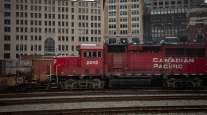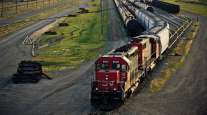Canadian Pacific Railway Sees End of the Line for Government-Owned Grain Cars

Canadian Pacific Railway Ltd. is ready to buy its own grain cars, sidelining 6,000 government-provided ones from the 1970s that are no longer up to the job.
“We know the kind of car that we want,’’ CEO Keith Creel said in an interview from Calgary, where the company is based. “We understand what the cash outlay is. It’ll be in the hundreds of millions of dollars.’’
Grain’s importance to the railroad makes rejuvenating the fleet a key issue to Creel’s stated goal of increasing revenue. The commodity is the biggest line of business for Canadian Pacific, accounting for about 23% of sales in the second quarter, and customers are growing tired of dealing with the antiquated “hopper” cars that are government property.
“You get to the customers, the gates don’t work properly,” Creel said in the interview July 19. Customers “don’t like to unload them. It’s labor intensive. They’re just not very reliable cars.”
Canada’s second-largest railroad will only move ahead, however, if proposed changes to the way the government accounts for rail investments get approved, Creel said. The current law provides little incentive for Canadian Pacific or its larger rival, Canadian National Railway Co., to spend on their fleets.
“As soon as we see the laws written, if they reflect what we think, we’re prepared to start as early as next year’’ to buy cars, Creel said. “We’re looking at a time frame of three to four years.”
Smaller Fleet
Canadian Pacific probably would look to purchase about 5,000 hopper cars, trimming the number of grain cars in the fleet, Creel said. The company has started discussions with rail-car makers, he said, without identifying them.
The railroad will “likely” revisit its full-year profit target at the end of the third quarter, Creel said July 19 on a conference call to discuss second-quarter earnings, which beat analyst estimates. The company is playing it safe with its forecast for a “high single digit” increase in adjusted per-share earnings because there’s too much uncertainty with oil and grain shipments, as well as the rising Canadian dollar, he said.
“The grain harvest is my biggest concern,” Creel said. “We will know by the end of the third quarter.”
With assistance by Josh Wingrove, and Jen Skerritt




